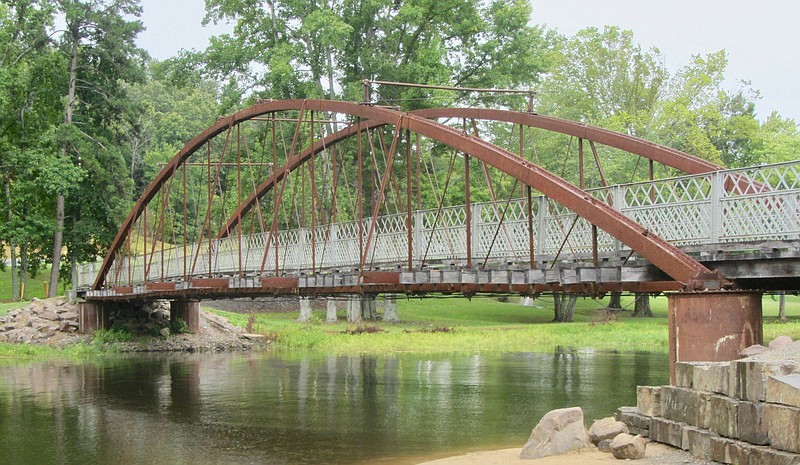CONWAY — The state of Arkansas was 3 years old and Ulysses S. Grant lived in the White House when Arkansas’ oldest surviving bridge was built.
It was 1874 when the Springfield-Des Arc Bridge was constructed to span North Cadron Creek, a dozen miles north of Conway. Plaques at one entrance to the 146-foot-long bridge, open to pedestrians, tell its fascinating history. It was moved wholesale in 2018 to Lake Beaverfork Park, Conway’s largest city park.
Arkansas swirled in post-Civil-War turmoil during the decade the bridge was built. Federal Reconstruction had temporarily given the state’s former slaves more or less full legal rights, but the Jim Crow era of legalized racial segregation loomed. It would commence after the jiggered election of President Rutherford B. Hayes in 1876.
At the same time, a degree of business prosperity was returning to our former Confederate state after war’s ravages. The improvement happened at a time when river transportation still played a major role in the state’s commerce, even as more railroad lines were being laid down.
In the 1870s, Springfield was the seat of Conway County, connected by a busy road to Des Arc, then a bustling steamboat port on the White River. Traffic on the route was slowed by the need to take a ferry across North Cadron Creek.
That led in 1871 to county officials awarding a contract to King Bridge Co. The firm built the bridge in Iola, Kan., to be shipped to Arkansas and assembled here in 1874. As well as being the Natural State’s oldest bridge, it is a rare surviving U.S. example of “bowstring arch truss” design.
It is close to amazing that Springfield-Des Arc Bridge still exists, whether on its original site or in Lake Beaverfork Park. The span “survived several near catastrophes over the years, and was even condemned as a danger,” reports the travel website atlasobscura.com .
Major floods in 1882, 1927 and 1982 rose above its wooden deck. Also, according to atlasobscura.com, the bridge “has burned, had a heavy dump truck fall through the floor on one occasion, and a bulldozer on another.”
The span gained a spot in 1988 on the National Register of Historic Places. But it closed to vehicle traffic three years later, replaced by a modern concrete structure just to the north. In 2015, it landed on a list of the eight Rock for cleaning and refinishing.
“The pieces were then trucked to Lake Beaverfork Park, where technicians reassembled it. New caissons were built, stones from the original abutments were incorporated into the approaches, and a railing was added. Finally, a crane lifted the bridge to its new home, Lake Beaverfork.”
That site choice was a happy one for visitors, in these covid-19 times or any other year. The lake is a choice spot for swimming and fishing, while land recreation includes a number of sporting fields. And there is plenty of outdoor space.
Getting There
From the Little Rock area travel I-40 to Conway, then take Exit 124A (Salem Road/ Arkansas 25 north) to Lake Beaverfork Park. The bridge is visible from the highway.
More information is available in the Springfield-Des Arc Bridge posting at encyclopediaofarkansas.net .
most endangered properties in Arkansas.
Around then, efforts by Conway city government and the Faulkner County Historical Society took action to move and preserve the bridge. An Iowa nonprofit firm, Workin’ Bridges, did the job for $508,000.
“Moving a 146-foot iron bridge is no small task,” notes one of the site’s plaques. “Two cranes lifted the bridge, then lowered it to the nearby ground. There ironworkers took it apart so it could be transported to North Little
Rock for cleaning and refinishing.
"The pieces were then trucked to Lake Beaverfork Park, where technicians reassembled it. New caissons were built, stones from the original abutments were incorporated into the approaches, and a railing was added. Finally, a crane lifted the bridge to its new home, Lake Beaverfork."
That site choice was a happy one for visitors, in these covid-19 times or any other year. The lake is a choice spot for swimming and fishing, while land recreation includes a number of sporting fields. And there is plenty of outdoor space.
